Novel approaches for Spatial and Molecular Surveillance of Porcine Reproductive and Respiratory Syndrome Virus (PRRSv) in the United States
- PMID: 28659596
- PMCID: PMC5489505
- DOI: 10.1038/s41598-017-04628-2
Novel approaches for Spatial and Molecular Surveillance of Porcine Reproductive and Respiratory Syndrome Virus (PRRSv) in the United States
Abstract
The US swine industry has been impaired over the last 25 years by the far-reaching financial losses caused by the porcine reproductive and respiratory syndrome (PRRS). Here, we explored the relations between the spatial risk of PRRS outbreaks and its phylodynamic history in the U.S during 1998-2016 using ORF5 sequences collected from swine farms in the Midwest region. We used maximum entropy and Bayesian phylodynamic models to generate risk maps for PRRS outbreaks and reconstructed the evolutionary history of three selected phylogenetic clades (A, B and C). High-risk areas for PRRS were best-predicted by pig density and climate seasonality and included Minnesota, Iowa and South Dakota. Phylodynamic models demonstrated that the geographical spread of the three clades followed a heterogeneous spatial diffusion process. Furthermore, PRRS viruses were characterized by typical seasonality in their population size. However, endemic strains were characterized by a substantially slower population growth and evolutionary rates, as well as smaller spatial dispersal rates when compared to emerging strains. We demonstrated the prospects of combining inferences derived from two unique analytical methods to inform decisions related to risk-based interventions of an important pathogen affecting one of the largest food animal industries in the world.
Conflict of interest statement
The authors declare that they have no competing interests.
Figures
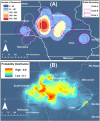
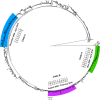
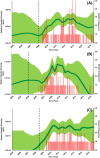
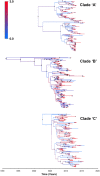
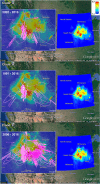
Similar articles
-
Surveillance of porcine reproductive and respiratory syndrome virus in the United States using risk mapping and species distribution modeling.Prev Vet Med. 2018 Feb 1;150:135-142. doi: 10.1016/j.prevetmed.2017.11.011. Epub 2017 Nov 16. Prev Vet Med. 2018. PMID: 29169685
-
Phylogenetic analysis of ORF5 and ORF7 of porcine reproductive and respiratory syndrome (PRRS) virus and the frequency of wild-type PRRS virus in México.Transbound Emerg Dis. 2018 Aug;65(4):993-1008. doi: 10.1111/tbed.12831. Epub 2018 Mar 4. Transbound Emerg Dis. 2018. PMID: 29504285
-
Detection of porcine reproductive and respiratory syndrome virus (PRRSV) 1-7-4-type strains in Peru.Transbound Emerg Dis. 2019 May;66(3):1107-1113. doi: 10.1111/tbed.13134. Epub 2019 Mar 2. Transbound Emerg Dis. 2019. PMID: 30688036
-
Porcine reproductive and respiratory syndrome in China.Virus Res. 2010 Dec;154(1-2):31-7. doi: 10.1016/j.virusres.2010.07.016. Epub 2010 Jul 24. Virus Res. 2010. PMID: 20659506 Review.
-
Evolutionary diversification of type 2 porcine reproductive and respiratory syndrome virus.J Gen Virol. 2015 Jul;96(Pt 7):1570-80. doi: 10.1099/vir.0.000104. Epub 2015 Feb 24. J Gen Virol. 2015. PMID: 25711962 Review.
Cited by
-
Land Cover and Climate Change May Limit Invasiveness of Rhododendron ponticum in Wales.Front Plant Sci. 2018 May 18;9:664. doi: 10.3389/fpls.2018.00664. eCollection 2018. Front Plant Sci. 2018. PMID: 29868106 Free PMC article.
-
Angiotensin II-mediated improvement of renal mitochondrial function via the AMPK/PGC-1α/NRF-2 pathway is superior to norepinephrine in a rat model of septic shock associated with acute renal injury.Ann Transl Med. 2021 Mar;9(6):481. doi: 10.21037/atm-21-621. Ann Transl Med. 2021. PMID: 33850878 Free PMC article.
-
Classification of porcine reproductive and respiratory syndrome virus in Ontario using Bayesian phylogenetics and assessment of temporal trends.Can J Vet Res. 2021 Apr;85(2):83-92. Can J Vet Res. 2021. PMID: 33883814 Free PMC article.
-
Porcine Reproductive and Respiratory Syndrome (PRRS) Epidemiology in an Integrated Pig Company of Northern Italy: A Multilevel Threat Requiring Multilevel Interventions.Viruses. 2021 Dec 14;13(12):2510. doi: 10.3390/v13122510. Viruses. 2021. PMID: 34960778 Free PMC article.
-
An assessment of enhanced biosecurity interventions and their impact on porcine reproductive and respiratory syndrome virus outbreaks within a managed group of farrow-to-wean farms, 2020-2021.Front Vet Sci. 2023 Jan 12;9:952383. doi: 10.3389/fvets.2022.952383. eCollection 2022. Front Vet Sci. 2023. PMID: 36713879 Free PMC article.
References
-
- Pork Checkoff. Top 10 Pork-Producing Countries Accessed December 2016. Available online: http://www.pork.org/pork-quick-facts/home/stats/u-s-pork-exports/top-10-....
-
- Quaife T. Scramble is on to solve mystery disease. Swine Practice. 1989;5:10.
-
- Holtkamp DJ, et al. Assessment of the economic impact of porcine reproductive and respiratory syndrome virus on United States pork producers. Journal of Swine Health and Production. 2013;21:72–84.
Publication types
MeSH terms
Substances
LinkOut - more resources
Full Text Sources
Other Literature Sources

